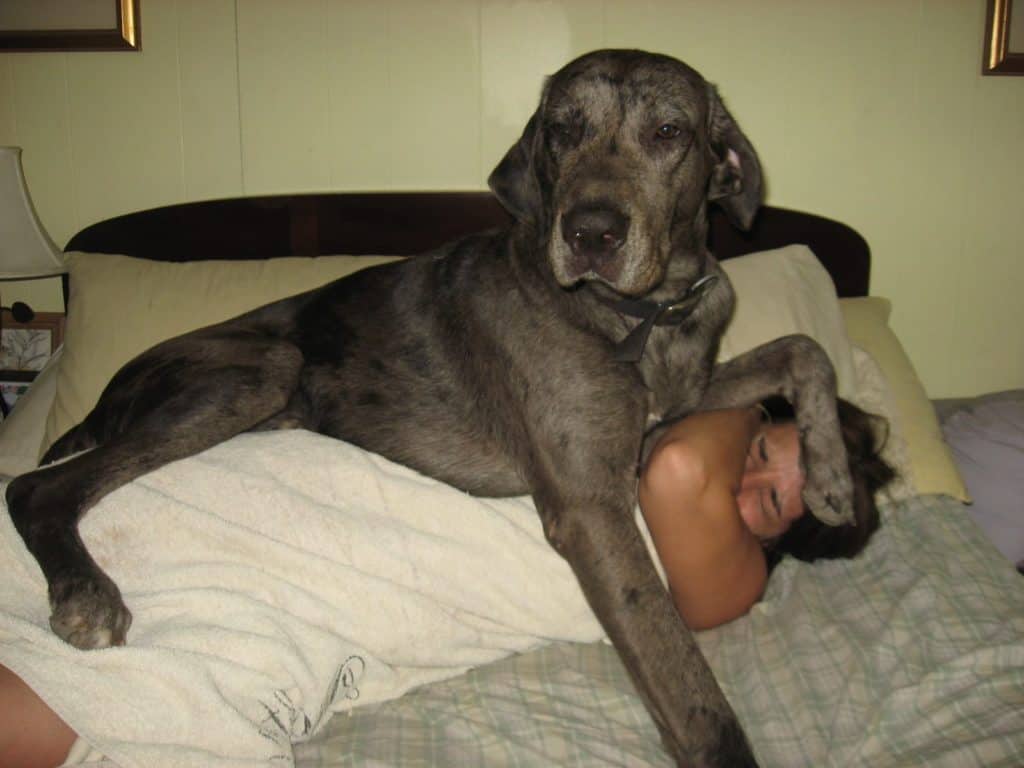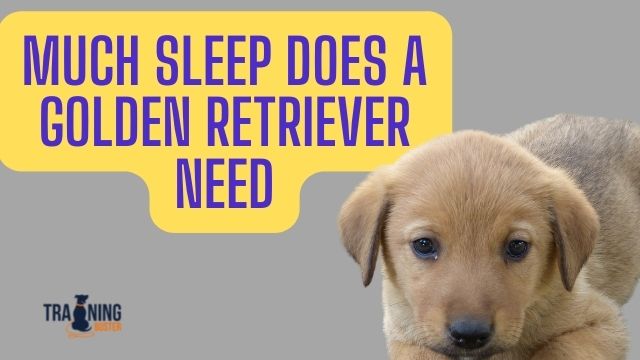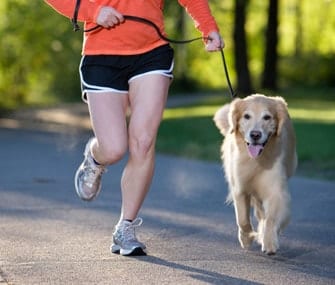
Is a Great Dane a Good First Dog To Own, find out in this article. The short answer to your question is:
Yes, Great Danes are huge, powerful, and elegant dogs. Males can reach 32 inches tall and weigh 100 to 120 pounds. Females are 30 inches tall and weigh 100 to 120 pounds.
A Great Dane is truly a great dog breed — large and noble, commonly referred to as a gentle giant or as the “Apollo of dogs.” Apollo is the Greek god of the sun, the brightest fixture in the sky.
The Great Dane certainly holds stature in the dog world; but though he looks terribly imposing, in reality, he’s one of the best-natured dogs around. For all of his size, a Great Dane is a sweet, affectionate pet.
Should I get a Great Dane? Is it a good first dog to own?
The Great Dane’s massive head is narrow and flat on top. The eyebrows are prominent. The ears drop forward or are cropped to stand erect. The neck is long and strong.
The Great Dane’s body is long, muscular and the front legs are straight. The tail is medium in length; it is thick at the base and tapers down to below the hocks.
Great Danes are light to average shedders. The coat is short and sleek and comes in a variety of colors including brindle or fawn, blue, black or harlequin, which has black patches over a white background.
The Great Dane was originally bred to hunt wild boar, but he probably wouldn’t be very good at it today. The ferociousness necessary to track down such a large, wily animal was eventually bred out of the Great Dane.
He’s now a gentle soul who generally gets along well with other dogs, animals, and humans.
However, his size and his power bark will scare the wits out of a burglar. Anyone who owns one of these dogs eventually understands that while you may be used to his awesome size, others usually need a little time to get there.
The Great Dane was developed from Mastiff-type dogs, but he’s more refined than other descendants of this ancient breed. A Great Dane is sleek and elegant.
He has an athletic, muscular body. His massive head — and massive is the right word — is long and narrow. He’s got a long, graceful neck. His ears can be cropped or left natural.
(Cropped ears are common in the U.S., but in other countries, ear-cropping is banned.)
His size can present problems. Eyeballing a dog who weighs what you do makes some folks nervous. His tail can knock over a lot of things, particularly in a small space.
And given the opportunity, he’s an impressive counter surfer. Luckily, he isn’t rambunctious or highly energetic.
Size notwithstanding, a Great Dane is a sweet, affectionate companion. He loves to play and is gentle with children. He has a peaceful disposition, although he hasn’t lost any of the courageousness that helped him hunt wild boar.
Although he isn’t particularly vocal (despite his killer power bark), he wouldn’t hesitate to defend his family.
Even given his inherent gentleness, it’s advisable to teach him good manners and attend obedience training classes when he’s young. His sheer size alone could make him impossible to control when he’s an adult, and — as with any dog — you never know when he might see something he just has to chase.
He’s eager to please and highly people-oriented, demanding a great deal of attention from those around him. He tends to nudge people with that big old head of his when he wants to be petted.
Sometimes you’ll meet one with lapdog tendencies who see no reason not to hop onto the sofa and drape themselves on you.
Surprisingly, the Great Dane typically doesn’t eat as much food as you’d think. And while he needs daily exercise, he doesn’t need a huge yard to play in (although he certainly would enjoy one).
Because of his beauty and gentle nature, more and more people are discovering the Great Dane. He currently ranks as the 24th most popular dog breed, according to registrations with the American Kennel Club.
Just be aware that because of his size, he’s got a relatively short life span of around eight years old. That means he takes up a huge space in your heart for a short amount of time.
History of the Great Dane
Drawings of dogs who look like Great Danes have been found on Egyptian artifacts dating back to 3000 B.C. and in Babylonian temples that were built around 2000 B.C.
There’s evidence that similar dogs originated in Tibet, with written reports of such dogs appearing in Chinese literature in 1121 B.C.
The breed is thought to have been taken into various parts of the world by the Assyrians, who traded their dogs to the Greeks and Romans. The Greeks and Romans then bred these dogs with other breeds.
Ancestors of the English Mastiff were probably involved in the breed development, and some folks believe that the Irish Wolfhound or Irish Greyhound also may have played a role.
Great Danes originally were called Boar Hounds, because boars were what they were bred to hunt. Their ears were cropped to prevent boar tusks from tearing them. In the 16th century, the name of the breed was changed to “English Dogges.”
Late in the 1600s, however, many German nobles began keeping the largest and most handsome of their dogs in their homes, calling them Kammerhunde (Chamber Dogs).
These dogs were pampered and wore gilded collars lined with velvet. Talk about a sweet life.
The name Great Dane arose in the 1700s when a French naturalist traveled to Denmark and saw a version of the Boar Hound who was slimmer and more like a Greyhound in appearance.
He called this dog Grand Danois, which eventually became a Great Danish Dog, with the more massive examples of the breed called Danish Mastiffs. The name stuck, even though Denmark did not develop the breed.
Most breed historians give credit to German breeders for refining the breed to be the well-balanced, elegant dog we love today.
In 1880, breeders and judges held a meeting in Berlin and agreed that since the dogs they were breeding were distinctly different from the English Mastiff, they would give it its own name — Deutsche Dogge (German Dog).
They founded the Deutscher Doggen-Klub of Germany, and many other European countries took up the name as well. The Italians and English-speaking countries didn’t accept this name, however. (Even today, the Italians call the breed Alano, meaning Mastiff; and in English-speaking countries, of course, they’re called Great Danes.)
Throughout the late 1800s, wealthy German breeders continued to refine the breed.
They turned their attention to the dog’s temperament because Great Danes had aggressive, ferocious temperaments due to the fact that they were originally bred to hunt wild boar, a particularly ferocious beast.
These breeders tried to produce more gentle animals, and — luckily for us today — they succeeded.
We don’t know when the first Great Danes were brought to the U.S., or even where they came from, but the Great Dane Club of America was formed in 1889. It was the fourth breed club allowed to join the American Kennel Club.
The personality of a great dane
A well-bred Dane is one of the best-natured dogs around. He’s a gentle, sweet, affectionate pet who loves to play and is relaxed with children. He has a great desire to please, which makes him easy to train.
The Great Dane wants to be where the family is. He likes people a lot, including strangers and children, and will welcome visitors happily, unless he thinks you need defending. Then he can be fiercely protective.
Some Danes wish they were (or truly believe they are) lapdogs, and they’ll keep trying to get there even if you and your lap mysteriously keep moving.
Good-natured as they are, Great Danes definitely need early socialization — exposure to many different people, sights, sounds, and experiences — when they’re young. Socialization helps ensure that your Great Dane puppy grows up to be a well-rounded dog.
Enrolling him in a puppy kindergarten class is a great start. Inviting visitors over regularly, and taking him to busy parks, stores that allow dogs, and on leisurely strolls to meet neighbors will also help him polish his social skills.
General Health
Not all Danes will get any or all of these diseases, but it’s important to be aware of them if you’re considering this breed.
If you’re buying a puppy, find a good breeder who will show you health clearances for both your puppy’s parents. Health clearances prove that a dog has been tested for and cleared of a particular condition.
Development Issues:
Growing problems can develop in puppies and young adults. These are sometimes associated with an improper diet — often a diet too high in protein, calcium, or supplements.
Hip Dysplasia:
This is an inherited condition in which the thighbone doesn’t fit snugly into the hip joint. Some dogs show pain and lameness on one or both rear legs, but others don’t display outward signs of discomfort.
(X-ray screening is the most certain way to diagnose the problem.)
Either way, arthritis can develop as the dog ages. Dogs with hip dysplasia should not be bred — so if you’re buying a puppy, ask the breeder for proof that the parents have been tested for hip dysplasia and are free of problems.
Gastric Torsion:
Also called bloat, this is a life-threatening condition that can affect large, deep-chested dogs such as Great Danes.
This is especially true if they are fed one large meal a day, eat rapidly, drink large volumes of water after eating, and exercise vigorously after eating. Bloat is more common among older dogs. It occurs when the stomach is distended with gas or air and then twists (torsion).
The dog is unable to belch or vomit to rid himself of the excess air in the stomach, and the normal return of blood to the heart is impeded. Blood pressure drops and the dog goes into shock.
Without immediate medical attention, the dog can die. Suspect bloat if your dog has a distended abdomen and is salivating excessively and retching without throwing up. He also may be restless, depressed, lethargic, and weak, with a rapid heart rate.
It’s important to get your dog to the vet as soon as possible if you see these signs.
Bone Cancer:
Sometimes known as osteosarcoma, this is the most common bone tumor found in dogs. It’s usually seen in middle-aged or elderly dogs, but larger breeds such as the Great Dane tend to develop tumors at younger ages.
Generally affecting large and giant breeds, osteosarcoma is aggressive bone cancer. The first sign is lameness, but the dog will need X-rays to determine if the cause is cancer.
Osteosarcoma is treated aggressively, usually with the amputation of the limb and chemotherapy. With treatment, dogs can live nine months to two years or more. Luckily, dogs adapt well to life on three legs.
Heart Disease:
Heart diseases affect Great Danes; varieties include dilated cardiomyopathy, mitral valve defects, tricuspid valve dysplasia, subaortic stenosis, patent ductus arteriosus, and persistent right aortic arch. Prognosis and treatment vary depending on the specific disorder and the dog’s age and general health.
Surgery:
Surgical issues are a bit different for Great Danes than for smaller dogs. For any needed surgery, find a surgeon who is experienced with giant-breed dogs. Ask for a presurgical blood test and ask them to include a clotting profile (this is not part of typical presurgical blood work).
Caring for your great dane
Despite his giant size, a Great Dane is mellow enough to be a good housedog, though he’s not well suited to a tiny apartment because he’ll knock into everything.
He can get cold in the winter, so he shouldn’t be left outside in colder climates — but then no dog should. In fact, he would enjoy having a sweater or fleece coat to keep him toasty warm when you go for a walk in a winter climate.
He’s relatively quiet indoors, but he needs a long walk at least once a day or a large yard to play in. An adult Great Dane needs 30 to 60 minutes of daily exercise, depending on his age and activity level. You can also exercise your dog at home find my 10 Ways to Exercise Your Dog at the home article here.
Puppies and adolescents need about 90 minutes of exercise a day.
If you plan on keeping him in a yard occasionally, he’ll need a six-foot fence, though he’s not a jumper. If you’re a gardening fan understand that he really enjoys destroying the landscaping (just a little safety tip in hopes of preventing human heart attacks).
While you may want a running partner, wait to take your Great Dane jogging until he’s at least 18 months old. Before then his bones are still growing, and they’re just not up to the task. In fact, he may not be ready to go jogging until he’s two. If you do run with your dog at night make sure you put on glow in the dark dog clothing and check out my other article Running With a Dog Safely
Crate training benefits every dog and is a kind way to ensure that your Great Dane doesn’t have accidents in the house or get into things he shouldn’t. A crate (a really big one) is also a place where he can retreat for a nap.
Crate training at a young age will help your Dane accept confinement if he ever needs to be boarded or hospitalized.
Never stick your Dane in a crate all day long, however. It’s not a jail, and he shouldn’t spend more than a few hours at a time in it except when he’s sleeping at night. Great Danes are people dogs, and they aren’t meant to spend their lives locked up in a crate or kennel.
Children around your Great Dane
A Great Dane loves children and is gentle with them, especially when raised with them from puppyhood. Keep in mind he doesn’t have any idea how big he is compared to a small child, and so can accidentally knock them over quite easily.
As with every breed, you should always teach children how to approach and touch dogs, and always supervise any interactions between dogs and young children to prevent any biting or ear or tail pulling on the part of either party.
Teach your child not to approach any dog while he’s eating or sleeping or to try to take the dog’s food away.
Generally speaking, a Great Dane will get along with other pets in the household, but occasionally some can be aggressive with livestock, or they just may not care for the other pets.
It’s an individual taste: some won’t tolerate another animal in the house, while others will snooze with the cats and other dogs.
Should I consider bringing home a rescue Great Dane?
Great Danes are often purchased without any clear understanding of what goes into owning one. There are many Danes in need of adoption and or fostering. There are a number of rescues that can be found in your area if you did a simple Google search.
If you don’t see a rescue listed for your area, contact the national breed club or a local breed club and they can point you toward a Great Dane rescue.
Does a Great Dane shed?
Great Danes shed a lot, but their coat is easy to keep in top condition with regular brushing. Use a firm bristle brush and shampoo as needed. Regular brushing keeps your Great Dane’s coat healthy and clean and cuts down on the number of baths he needs.

ORDER OUR NEW BOOK – Dog Training for Beginners
- Socialization
- Training with a leash
- Problem behaviors
- Obedience training
- Advanced & Service Tricks


